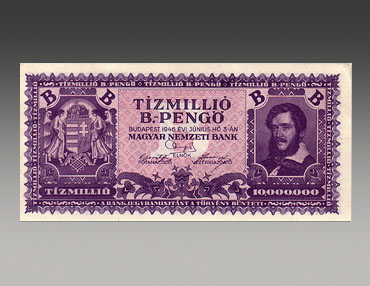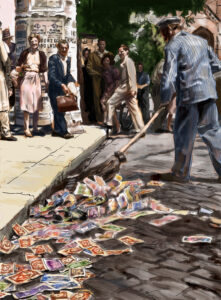
10 Quintillion Pengo Hyperinflationary Note
Hungary
June, 1946.
Inflation is a marching increase in the general price of goods and services over a period of time. It’s caused by an increase in a country’s money supply that dilutes its value. Hyperinflation, on the other hand, is a dead run.
One key ingredient for a hyperinflation is paper currency, which is of no intrinsic value but based solely on public faith. Many nations have suffered devastating hyperinflation that impoverished their people. For example, France in 1795-6, Germany in 1923, Bolivia in 1985, and Zimbabwe in 2008 all suffered. However, the worst case of hyperinflation in all of history was in Hungary in 1946.
In 1944, Hungary became a World War II battleground between Germany, Russia, and the US. Almost all of its industrial capacity and rail transportation was damaged or destroyed, leaving a shell at war’s end in 1945.

With no tax base to rely upon, and little public savings in banks, the Hungarian government decided to stimulate the economy by printing and loaning out massive amounts of money. In July of 1945, there was approximately 25 billion Pengö, the national currency, in circulation. Six months later, that figure had risen to 1.65 trillion Pengö, and by the height of the hyperinflation in July of 1946, 47 trillion trillion paper Pengö were circulating, more on the ground as trash than in wallets and purses.
With prices skyrocketing for goods, the paper currency had to grow in numbers as well. Prior to the hyperinflation, the largest bill was 1,000 Pengö. At the end of 1945, that had increased to 10,000,000 Pengö, or 10 Mil-Pengö. Shortly thereafter came the B.-Pengö, which was 1,000,000,000,000 (1 trillion) Pengö, and by July, the largest denomination in circulation was the 100 million B.-Pengö, or 100,000,000,000,000,000,000 Pengö. By the end of the hyperinflation, this bill was worth about 20 cents in American money.
By the time the Pengö was replaced by the forint in August of 1946 (at an exchange rate of 400 octillion Pengö to one), the total value of all Hungarian Pengö banknotes in circulation amounted to 1/1,000 of one US cent.
The specimen acquired by the museum is a Hungarian 10,000,000,000,000,000,000 (10 quintillion) Pengö bill, issued near the peak of their hyperinflation.